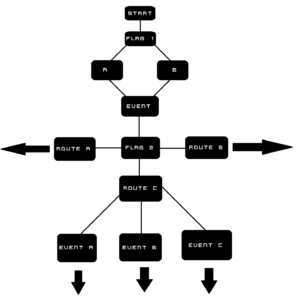For this story, my initial idea was to create a three-movement piano composition evoking imagery of the Earth before some apocalyptic downfall, during, and after. The piece itself would play into the story, being crafted by the protagonist over the course of several small-scale and interpersonal conflicts, also reflecting the personal breaking-down and rebuilding of the protagonist. By this point, I’ve laid out the course of events in the plot of the story as well as a couple motifs and the overarching theme and composed a small portion of the first movement of the piano piece and noted the general sound I would like for the other two. The pieces would then autoplay in the WordPress post in which the story would be posted, at specified parts of the story.
Unfortunately, at this point in the semester, due to some other class’ duties and an unexpectedly busy work schedule, I don’t think I have the time to see this idea through to fruition. Certainly not to the degree of quality I want for this; this would be my first full original composition on piano, and I don’t want it to feel rushed when I look back on it. Writing the story is one thing, but I simply don’t have the time anymore to spend at a piano with a couple sheets of musical bars for any long enough period to satisfyingly compose something meaningful.
Fortunately, however, the recent work in Twine has inspired an alternative idea, something that can only function exclusively in a digital format.
I would like to create my own text adventure game using Twine and all the custom tools it encompasses. A story where the player takes the role of a nameless figure with amnesia who finds himself or herself alone in a world post-energy collapse and works to uncover the mystery of what happened between the time of the story and his/her latest remaining memories, from when they were a child in a world similar to our own now.
There’s one catch to it to differentiate from your average adventure game: I won’t incorporate any game-over states. The player won’t be able to “lose” at any point, every option is a valid one. There will be a huge range of decisions that branch off to completely unique paths, each revealing something different about the history of the story world, the character himself/herself, and the remainder of society. But each branch will end at some point, so one would have to replay the game many times over to get the full picture of the world. However, I hope to provide a conclusion at all points that satisfy the player enough to justify ending with that branch.
The general flow of the game would be as follows:
 Of course this isn’t indicative of the final design. The above image serves to demonstrate the logical flow of the story narrative in the typical way a text adventure or novel game would progress. Notably, unseen, each node in this route (that is, each lexia in Twine) would have some element of interactivity to it besides redirecting and branching off into new routes. Some words or items that appear in one lexia may be variable according to user input and thus affect later lexias along that path.
Of course this isn’t indicative of the final design. The above image serves to demonstrate the logical flow of the story narrative in the typical way a text adventure or novel game would progress. Notably, unseen, each node in this route (that is, each lexia in Twine) would have some element of interactivity to it besides redirecting and branching off into new routes. Some words or items that appear in one lexia may be variable according to user input and thus affect later lexias along that path.
I’m comfortable enough with my abilities to utilize Twine and various HTML and CSS features, to write a single cohesive narrative world with multiple branching paths, and that I’ll have the time available to allot to this in order to create an interactive story of a quality I would be content with.
This is an intriguing idea and one well suited for Twine: A story where the player takes the role of a nameless figure with amnesia who finds himself or herself alone in a world post-energy collapse and works to uncover the mystery of what happened between the time of the story and his/her latest remaining memories
A few questions:
1-what is the incentive to keep exploring?
2- do all the scenarios add up to a single reality, or are some version conflicting or confusing? (like the real world likely, where not everything always adds up)
3-what is the end state of the story? i.e. does each new ending add to our overall satisfaction with a developing ‘big picture’?
4-how do you address plot issues: how does the reader/protagonist confront a mystery/challenge or obstacle and then how does change occur for him/her? i.e. could the answer be surprising? i.e. if we all stopped using cars, buying cellphones, or eating meat, or working such long hours (more productivity=more earth damage…), we could avoid the crash? or do GMOs pose an unheeded threat that led to plagues and crop loss and so food shortages that brought down a fragile system? or all the above in different locations? or were there positive options that were quashed? unrealized? or maybe some actually made possible the survivors situations? you might find Holmgren’s Four Scenarios inspiring here, as he mentioned all will likely overlap in different parts of society. Like right now Detroit and Lagos Nigeria are Brown tech areas; Maine is a lifeboat, Vermont is green tech, etc…
or is it just that we were already in the future that came in bits and pieces but weren’t paying attention…that media prevented earth’s feedback mechanisms from working on humans…fake news…